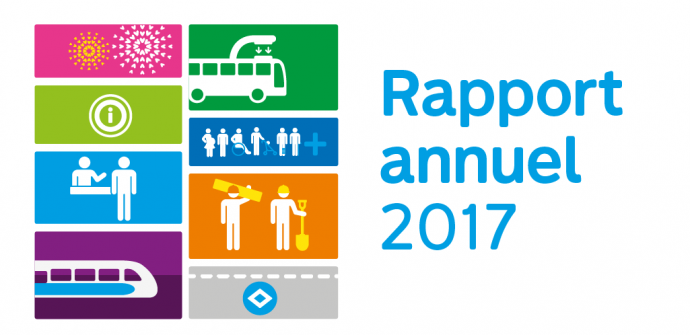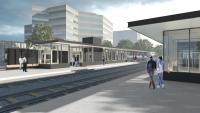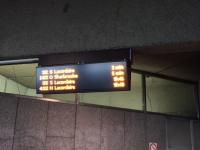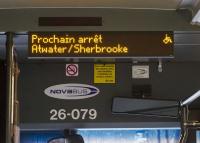The STM released today its 2017 Annual report, a year marked, among other tings, by a revision of its Strategic plan, the acceleration of important projects and an increase in ridership.
Montréal, April 26, 2018 – On the heels of its 10-billionth métro boarding, the Société de transport de Montréal (STM) has released its 2017 Annual Report. The year’s highlights, among other things, include a revision of the STM’s strategic plan, which was necessary for the corporation to adapt to the new transportation governance model and achieve its customer-oriented shift.
In the same spirit, the STM speeded up its investments in asset maintenance, among other reasons to improve accessibility, while enhancing riders’ experience by making substantial headway on several major projects. The STM was able to do all of this while chalking up higher ridership.
Toward excellence in mobility
During the year, the STM presented its 2025 Strategic Organizational Plan (SOP 2025), built around the vision of “excellence in mobility”. It continued its customer shift begun in 2015 and adhered to the new public transit governance model for the metropolitan area, built around four broad strategic orientations:
- Improving the customer experience
- Adapting the organization to evolving governance
- Bringing finances under control
- Attracting, developing and mobilizing talent
Philippe Schnobb, chairman of the STM board
“We’re proud of the work accomplished over the past year, and the future looks bright. The new municipal administration has asked the STM to speed up delivery of its SOP 2025, for the benefit of customers, and we’re already in action mode.”
Delivering promised service: a priority
During a year filled with challenges for its transportation network, including numerous worksites on streets and roads and in stations, tunnels and even transportation centres, the STM was able to maintain a planned bus system service delivery rate of 99.4%, contributing to a 2% rise in customer satisfaction with the bus system, to 78%.
As for the métro, the service offer reached a peak last year with an increase of 7.8%. The last service boost of such importance dates back to the opening of the orange line in Laval, ten years ago. These service enhancements, notably to help getting round Montreal during the major events, as well as the synchronization of the orange and green line trains, contributed to a planned service delivery rate of 101%.
Increased ridership
STM ridership was up 3.2%, to 429.5 million rides. This increase may be explained by the activities held to celebrate Montréal’s 375th birthday, which drew thousands of participants, along with enhanced service provided by the STM and the vigorous economy. The STM also posted over 4 million paratransit rides for the first time in the history of this service.
Better management of métro service disturbances
The Montréal métro chalked up 4% more boardings in 2017, with a record 260 million. This increased ridership, combined with the fact that métro trains travelled more in 2017 than in 2016, as well as accelerated integration of the new AZUR trains, led to a greater number of service interruptions of five minutes or more, for a total of 1,171.
More than 40% of these service interruptions were caused by customer behaviour (people who fall ill, doors held open, objects on the tracks, etc.). In 2017 alone, approximately 550 objects fell on the tracks, causing over 19 hours of service interruptions, and 337 incidents of held doors led to 25 hours of service delays. A communication campaign on this issue was launched recently. To help reduce these incidents, the STM is continuing to deploy support teams to ease customer transit flow in the busiest métro stations during morning and evening rush hours.
The STM has also implemented a new customer communication strategy aimed at improving information for its users in the event of service disturbances:
- Operators are asked to communicate with their passengers 30 to 90 seconds following a service disturbance.
- More specific messages are broadcast in the stations and via information tools.
- Twitter feed support has been expanded.
- The STM also informs its customers who have yet to begin their ride by broadcasting métro service information on Cogeco stations.
Increased asset maintenance efforts
Infrastructure in good condition is a prerequisite for high-quality public transit. That is why the STM invests massively in renovating its infrastructure.
Luc Tremblay, STM chief executive officer
“Investments have tripled in three years, to approximately $1 billion for 2017. The STM has outperformed its annual targets, delivering 105.7% of planned projects, the like of which has never been seen before at the STM! We renovate and upgrade our network while operating and even expanding it!”
A number of facility upgrade projects are currently under way, aimed at promoting universal access, optimizing functionality and improving aesthetics. All of these projects help enhance riders’ experience.
Status of major projects
The loan by-law for construction of the Bellechasse transportation centre, a $254 million project, was passed last summer. The project is aimed at replacing the current Saint-Denis transportation centre, built in 1957 and approaching the end of its useful life, to enable the STM to meet its current and future operational needs and improve its customer service. The new building will be able to house up to 207 buses (105 regular buses and 102 articulated buses) and will be equipped to recharge electric buses.
The professional services contract enabling work to begin on plans and specifications should be awarded in the coming weeks. Work at the site is expected to get under way in 2019.
Construction of the Côte-Vertu garage began in May 2017. This major project is aimed at adding parking spaces for trains, improving service frequency by the addition of trains on the Orange line during rush hours and supporting increased ridership and the planned enhancement in service for the coming years, taking into account factors such as the eventual extension of the Blue line.
Three auxiliary structures will be visible above ground level. One of them, the maintenance workshop access structure, will be equivalent to a ten-storey building, with seven of the storeys underground. These access points will enable garage operations. The underground garage itself will be located about 25 metres below the surface. It will consist of a fan of tracks, a train maintenance tunnel, two train garage tunnels and a connecting tunnel linking the garage to the back of the Côte-Vertu station. The necessary excavation for the new infrastructure involves dynamiting for the vertical shafts and mechanical (cutting machine) excavation for the tunnels. The cutting machine is specially designed for mechanical excavation in rock, and use of this equipment will minimize the negative impact on the neighbourhood by limiting vibrations and noise.
A major project involving a number of technical challenges is under way at the Vendôme intermodal hub. The project is aimed at connecting the métro station and RTM train station to the McGill University Health Centre (MUHC), with the addition of a new, universally accessible building. A total of five elevators will be installed, facilitating transfers between the MUHC and the public transit facilities. The preparatory work has now been completed, and excavation of the sites of the future STM and RTM buildings is well under way. The pace of the project has been accelerated, with work day and night. Certain steps in the project close to the railway tracks cannot be completed during the day, and night work has been authorized by the borough. The work should continue until next fall.
The métro system currently has 12 accessible stations, and the STM plans to double or even triple the pace of installation of elevators, so that 31 stations are accessible in 2022 and the entire system is accessible in 2038. Elevators have been operational at the Place-D’Armes station since 2017, and installation is currently under way at three stations (Honoré-Beaugrand, Du Collège and Vendôme). Work should also begin during the year at the Jean-Drapeau, Mont-Royal, Viau, Jean-Talon and Berri-UQAM stations.
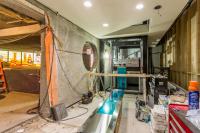

In May last year, the STM began providing passenger service on the 36-Monk bus line via three quick-charging electric buses. The buses are recharged at quick-charge stations located at the end of the line, at Square Victoria and the Angrignon terminus, and their batteries are balanced at night at the transportation centre. Quiet, air conditioned, comfortable and environmentally friendly, the buses are popular among passengers and drivers.
The STM has also announced that it plans to acquire 40 electric buses of various types using different technologies, in order to test them in an operational, planning and maintenance context. A loan by-law for the acquisition of four electric mid-size buses was recently authorized by the City of Montréal Executive Committee.
As part of its iBUS project, the STM has finished activating in-bus displays for visual and audio announcements of upcoming stops, and has deployed a new system-wide operations centre. All 90 passenger information terminals located in métro stations and at busy bus stops are now up and running. Beta mode real-time information has been successfully deployed for four tools, namely the desktop and mobile websites, and the Transit and Chrono apps. Bus geopositioning is now also available on the system map by means of these four tools.
Deployment of EXTRA Connecte, a real-time trip management system, is ongoing. When fully implemented, this tool will provide users with real-time service status information and optimize the use of financial resources and vehicles. Since 2017, paratransit users have been able to obtain specific information about their trips, including day-before notifications (by text message, email or phone) and trip cancellation notifications to inform them adequately in the event of incidents beyond the STM’s control (broken water mains, fires, etc.). In the coming months, start-up of the new control room will mean more efficient service delivery. By the end of 2018, real-time management will also be available for all minibuses and some taxis, for more punctual service and accurate information. As of 2019, notifications for customers a few minutes before their transportation arrives will also be available.
Deployment of AZUR trains on the Orange line is proceeding smoothly. The STM currently operates 40 AZUR trains, most of them on the Orange line, along with two AZUR trains deployed for customer service on the Green line following tests last summer. The remaining trains should be delivered by the end of 2018. Under an agreement reached to compensate for project delays, two additional trains will be delivered.
The arrival of the new métro trains means that the oldest MR-63 trains will be replaced on the Green and Yellow lines by more recent MR-73 cars. The STM is retiring its MR-63 rolling stock. Over the past year, two cars were sold to entrepreneurs for cultural and real estate projects and 253 cars were sent for recycling. Thanks to the quality of its efforts to derive value from its MR-63 métro cars, the STM was singled out for a Novae award, providing tangible recognition for one of Québec’s best sustainable projects.
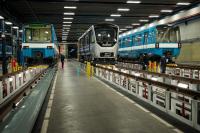
In July, mobile communication was accessible in over 50% of the métro system, and at the end of the year a total of 51 stations were connected. All told, 11 stations were connected in 2017, enabling customers to use their mobile devices to make phone calls, exchange text messages and surf the Web on the Green line between the Lionel-Groulx and Beaudry métro stations, on the entire Yellow line, on the Orange line between the Côte-Vertu and Jarry stations, and on the Blue line between the Snowdon and Jean-Talon stations. By the end of the year, the remaining sections of the Orange and Blue lines should be connected, and mobile coverage should be available throughout the entire métro system in 2020.
Useful links (available in French only)
- Rapport annuel 2017 de la STM
- Rapport de développement durable 2017 de la STM
- Rapport d'état d'avancement du PSO 2025, du Plan DD 2025 et du Plan AU 2016-2020 de la STM
Luc Tremblay, STM chief executive officer, is available for interviews.
- 30 -
Philippe Déry
Conseiller Affaires publiques
STM
514 350-0800 #87346
medias@stm.info
